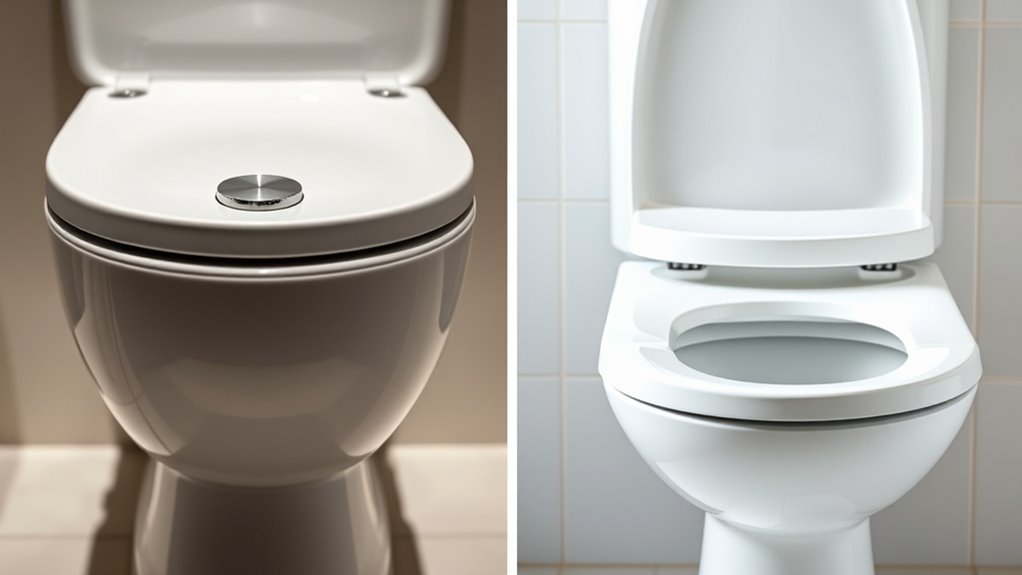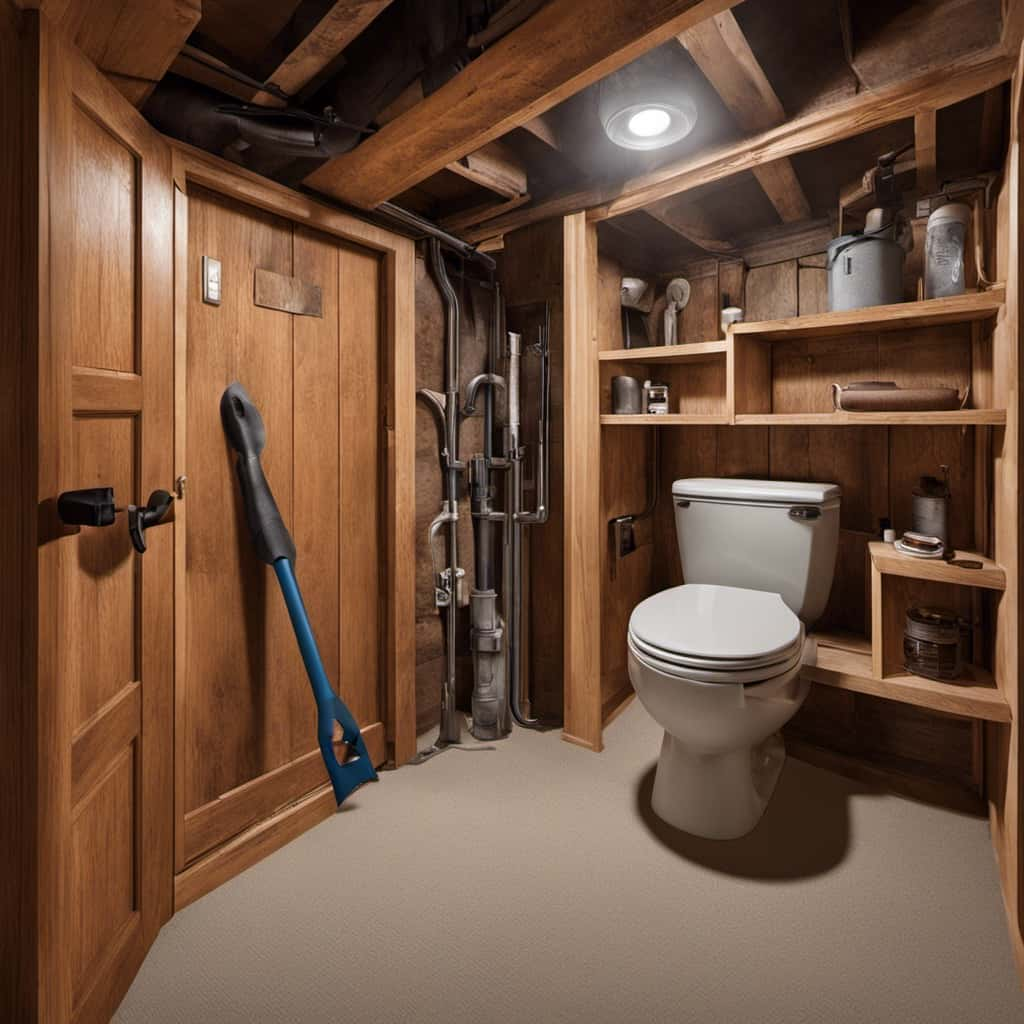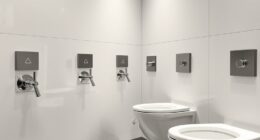Pressure-assisted toilets use compressed air for a powerful, quick flush, saving water but generating more noise and higher initial costs. Gravity-flush models rely on water flow driven by gravity, usually being quieter and easier to install, but may use more water over time. Both systems aim to prevent clogs and improve efficiency, but your choice depends on your priorities for noise, budget, and water savings—exploring these details can help you decide which is best for your home.
Key Takeaways
- Pressure-assisted toilets deliver more powerful, quick flushes using compressed air, ideal for reducing clogs and improving efficiency.
- Gravity-flush models rely on gravity for water flow, typically quieter and easier to install and maintain.
- Pressure-assisted toilets generally consume less water per flush, promoting better water conservation.
- They tend to be noisier during operation, while gravity models are usually quieter.
- Initial costs for pressure-assisted toilets are higher, but they may save money through lower water bills over time.
How Pressure-Assisted Toilets Work

Pressure-assisted toilets use compressed air to deliver a powerful flush. When you activate the handle, the pressure mechanism kicks in, releasing compressed air into a tank that is connected to the water supply. This pressurized air forces water into the bowl with greater force than gravity alone, resulting in a strong, efficient flush. Unlike traditional toilets that rely solely on water pressure from your plumbing system, these units have a sealed tank that combines water pressure with added air pressure. This combination creates a forceful push that clears waste quickly and effectively. You’ll notice that pressure-assisted toilets use less water overall, thanks to the enhanced flushing power provided by the compressed air and water pressure working together. Additionally, the sealed tank design helps reduce noise during flushing, making it a quieter option. The air pressure mechanism also contributes to a more consistent flushing performance over time, and advanced engineering ensures durability and reliable operation.
How Gravity-Flush Toilets Function

When you flush a gravity-flush toilet, water from the tank rushes down through the bowl, carrying waste with it. The flushing mechanism relies on a flapper or valve that opens to release water, creating a strong flow that moves waste into the drain. A tight seal and proper drainage guarantee everything clears efficiently, making the process smooth and reliable. Advances in toilet technology, such as improved flushing mechanisms, continue to enhance effectiveness and reduce water usage. Proper maintenance and understanding of relationship dynamics can also contribute to more harmonious household environments. Additionally, innovations like smart toilet features are beginning to improve user experience and sanitation standards.
Flushing Mechanism Operation
Gravity-flush toilets operate by relying on the force of gravity to move water from the tank into the bowl, creating a powerful flush. When you activate the handle, a flapper lifts, releasing water from the tank into the bowl. This sudden flow pushes waste through the trap and into the drainpipe. The flushing mechanism’s design influences environmental impact since it determines water efficiency; older models tend to use more water, increasing environmental strain. Aesthetic design also plays a role, as modern gravity-flush toilets often feature sleek, unobtrusive shapes that blend with various bathroom styles. The simplicity of this mechanism means fewer parts are prone to failure, making maintenance easier. Overall, the operation’s efficiency and design impact both environmental sustainability and the bathroom’s visual appeal.
Water Flow Dynamics
The water flow in gravity-flush toilets is driven primarily by the force of gravity, which pulls water from the tank into the bowl through an opening called the flush valve. As water rushes downward, fluid dynamics come into play, creating a powerful siphon effect that clears waste efficiently. During this process, air pressure differences influence flow speed, helping or hindering the flush. You’ll notice:
- A swift rush of water that dislodges debris effortlessly
- The creation of a siphon that maximizes waste removal
- How fluid dynamics and air pressure work together to sustain a smooth, continuous flow
- Understanding water flow dynamics is essential for optimizing toilet design and performance. Additionally, the efficiency of gravity-flush toilets can be affected by design considerations, which impact the overall effectiveness of the flush mechanism. Proper water movement within the system ensures consistent operation and minimizes blockages. This seamless interaction relies on the physical properties of fluids and the pressure differences that drive flow, which are fundamental concepts in fluid behavior. Recognizing the role of fluid behavior helps in improving toilet performance and addressing common issues.
Seal and Drainage
Ever wonder how a gravity-flush toilet keeps waste contained and clears it efficiently? It all comes down to seal integrity and drainage design. The seal, usually a rubber ring called a wax ring, prevents leaks between the bowl and the drain pipe, maintaining a tight barrier. This ensures that odors stay out and waste stays in the bowl. The drainage design uses gravity to move water and waste swiftly through the trap and into the sewer system. The shape of the trap creates a water seal that blocks sewer gases while allowing waste to flow freely when flushed. Proper seal integrity and an efficient drainage design work together to ensure the toilet functions smoothly, minimizing clogs and preventing leaks. Additionally, understanding the water flow in the drainage system helps optimize the toilet’s performance and prevent issues. Proper drainage design ensures the system remains effective over time, reducing maintenance needs and supporting overall glamping site sanitation standards. Ensuring the seal and drainage system are properly maintained is essential for long-term operation and hygiene.
Flushing Power and Efficiency Comparison

While both pressure-assisted and gravity-flush toilets are designed to clear waste effectively, their flushing power and efficiency can vary considerably. Pressure-assisted models deliver a powerful, forceful flush that minimizes the need for multiple attempts, giving you confidence in every use. Pressure-assisted toilets use pressurized air for a quick, vigorous flush, reducing clogs and waste residue. Gravity-flush toilets rely on the weight and design aesthetics to provide a steady, reliable flush, though they might require more water per flush. Consider these key points: 1. power: Pressure-assisted toilets use pressurized air for a quick, vigorous flush, reducing clogs and waste residue. 2. Efficiency: Gravity models often consume more water, but some newer designs improve overall efficiency. 3. User comfort: Both types can offer comfort, but pressure-assisted toilets tend to provide a more satisfying, consistent flush experience. Additionally, understanding how flushing mechanisms work can help you make a more informed decision. Knowing about water usage and tuning options available for different models can also influence your choice based on performance needs. Exploring toilet design features can further enhance your understanding of how these systems function and their long-term benefits. Modern flushing technology has introduced innovations that can optimize performance and water saving, making it worth considering for your bathroom upgrades. Choose based on your priorities for performance, aesthetics, and comfort.
Noise Levels During Flushing
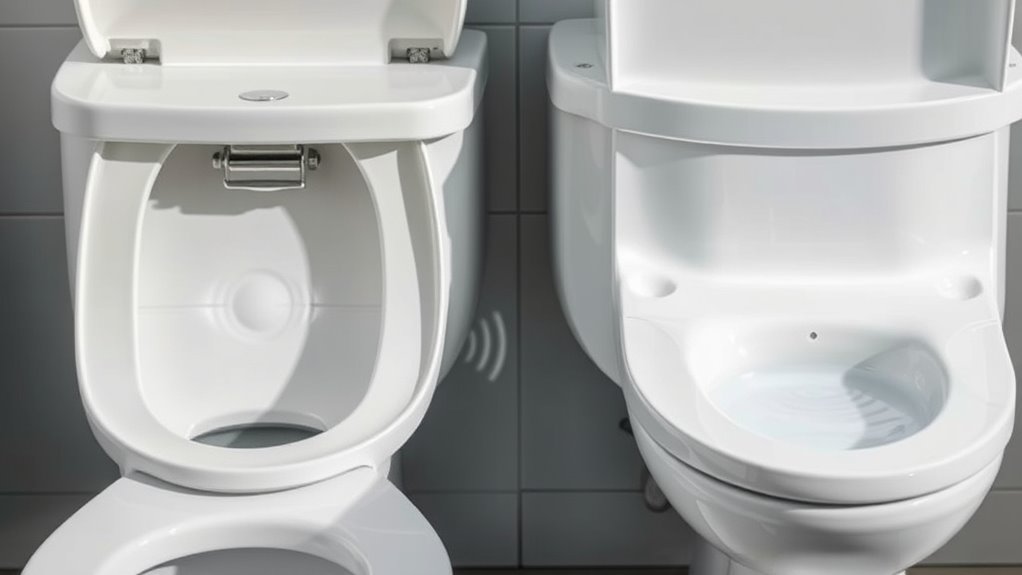
When considering noise levels during flushing, pressure-assisted toilets generally produce louder sounds compared to gravity-flush models. These toilets generate a forceful flush, which can produce a loud noise that might disturb quiet environments. To minimize this, look for models with good sound insulation features designed to dampen noise. Mattress toppers can also help absorb some of the sound and vibrations during flushing. Additionally, some models incorporate soundproofing technology to further reduce noise levels. Gravity-flush toilets tend to be quieter because they rely on the natural pull of gravity, resulting in less sound during operation. If noise reduction is a priority in your space, consider the sound insulation qualities of the toilet or add insulating materials around the tank. While pressure-assisted models offer powerful flushing, they often come with increased noise levels, so weigh this factor when making your choice.
Water Usage and Conservation

When choosing between pressure-assisted and gravity-flush toilets, water efficiency plays a big role in your conservation efforts. Understanding how each type impacts water usage and costs can help you make smarter choices. Considering these factors guarantees you save water and money while reducing your environmental footprint.
Water Efficiency Comparison
Water efficiency is a key factor to contemplate when choosing between pressure-assisted and gravity-flush toilets. Both designs aim to conserve water, but their efficiency impacts your daily use and overall sustainability. Consider these points:
- Lower water consumption: Modern pressure-assisted models often use less water per flush, reducing your utility bills.
- Effective waste removal: Pressure-assisted toilets deliver stronger flushes, minimizing repeats and conserving water.
- Design aesthetics and user comfort: Sleek designs enhance your bathroom’s look, while comfortable, reliable performance encourages mindful water use.
Conservation Impact Factors
Choosing the right toilet substantially impacts your overall water conservation efforts. Both pressure-assisted and gravity-flush models influence water usage and environmental benefits. Pressure-assisted toilets typically use less water per flush, reducing overall consumption and preserving essential water resources. Gravity-flush toilets, while often using slightly more water, can still be efficient if designed with conservation in mind. Material sustainability also matters; selecting toilets made from eco-friendly, durable materials minimizes environmental impact and ensures longevity. By understanding these conservation impact factors, you can make informed choices that support water-saving initiatives while promoting environmental benefits. Your selection not only saves water but also contributes to a more sustainable future, reducing waste and lowering your ecological footprint over time.
Usage Cost Implications
Your selection between pressure-assisted and gravity-flush toilets directly impacts ongoing water costs and conservation efforts. With pressure-assisted models, you typically save water due to efficient flushing, which lowers your monthly bills. However, they often have higher installation costs, which can be a financial hurdle upfront. Gravity-flush toilets usually cost less initially but use more water per flush, increasing future expenses. Consider these points:
- Saving water means reducing your environmental footprint and long-term bills.
- Higher installation costs for pressure-assisted toilets might be offset by lower water bills.
- Maintenance expenses for pressure-assisted models can be higher due to complex mechanisms, affecting your budget over time.
Choosing wisely impacts both your wallet and the planet.
Installation and Maintenance Considerations
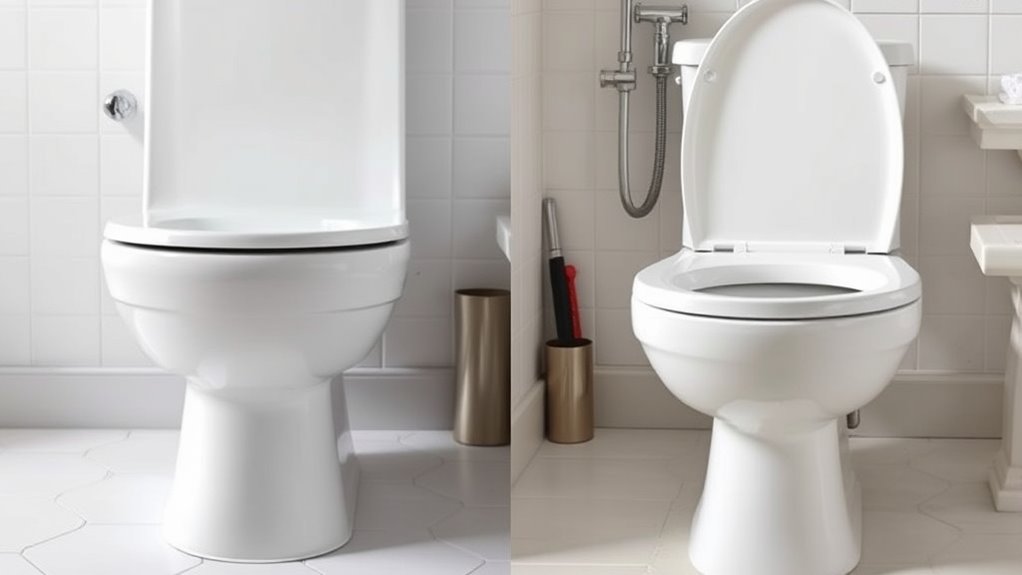
When installing a pressure-assisted or gravity-flush toilet, careful attention to the manufacturer’s instructions is essential to guarantee proper setup and peak performance. Pressure-assisted models often present installation challenges due to their complex components, requiring secure connections and proper tank placement. Gravity-flush toilets tend to be easier to install but still demand precise alignment with the drain and flange. Regular maintenance routines differ between the two; pressure-assisted toilets may need more frequent inspections of the pressure vessel and valves, while gravity models mainly require checking for leaks and sediment buildup. Ensuring proper installation reduces the risk of leaks and clogs, extending the lifespan of your toilet. Staying diligent with maintenance helps keep both types functioning efficiently and prevents costly repairs down the line.
Cost Differences and Budget Impact

Pressure-assisted toilets typically cost more upfront than gravity-flush models due to their advanced components and installation requirements. You might face higher installation costs because these toilets often need specialized parts and professional setup. Additionally, brand availability can influence your budget, as popular brands tend to be more expensive but offer better reliability. Consider these key points:
Pressure-assisted toilets cost more upfront due to advanced parts and installation needs.
- The initial purchase price can be 30-50% higher, impacting your immediate budget.
- Limited options in certain regions might drive up costs due to reduced competition.
- Long-term maintenance expenses could be higher, especially if specialized parts are needed later.
While the upfront investment is greater, you’ll need to weigh these costs against potential savings from reduced water bills over time.
Pros and Cons of Each Toilet Type
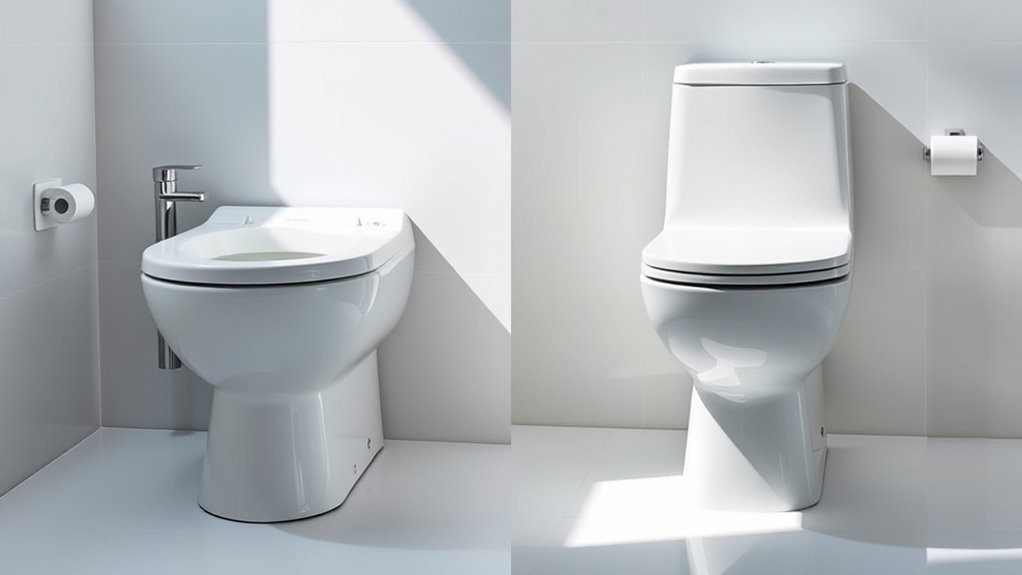
Both pressure-assisted and gravity-flush toilets have distinct advantages and drawbacks that can influence your choice. Pressure-assisted models often feature sleek design variations that save space and provide powerful flushing, making them ideal for heavy usage or where water efficiency matters. However, they tend to be louder and more expensive to repair. Gravity-flush toilets are generally quieter and easier to maintain, with many design options to fit various bathroom styles. They may use more water and sometimes require more force to flush completely. Your user preferences, such as noise tolerance, budget, and desired aesthetics, will guide which type suits you best. Weighing these pros and cons helps you select a toilet that aligns with your needs and bathroom setup.
Which Toilet Type Is Right for You?
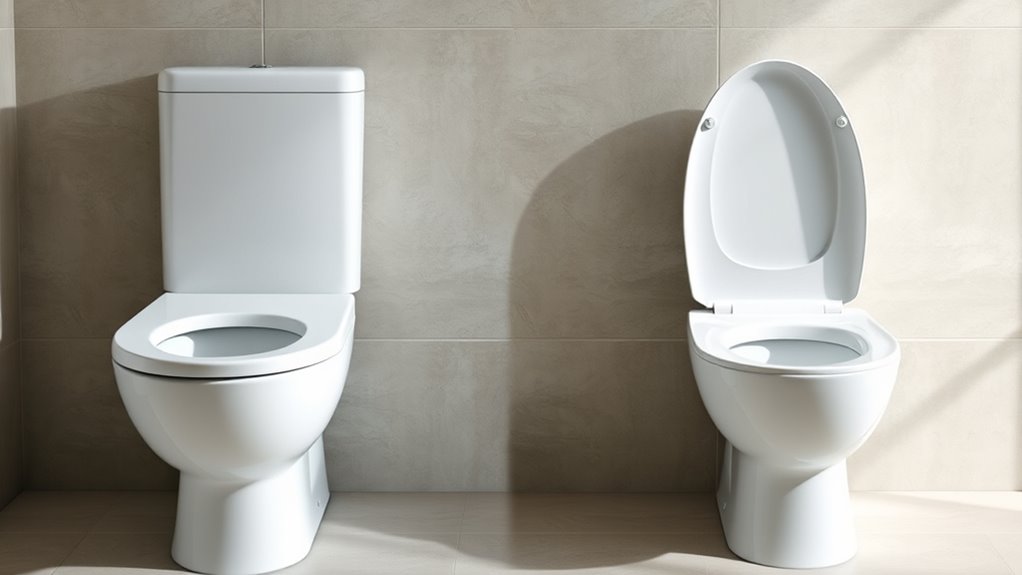
Choosing the right toilet depends on your priorities and bathroom setup. Think about what matters most—are you looking for durability, style, or efficiency? Here are three factors to consider:
Selecting the perfect toilet depends on your priorities—durability, style, or efficiency.
- Toilet material: Porcelain offers durability and easy cleaning, while newer materials might add aesthetic appeal.
- Toilet aesthetics: Match the design to your bathroom’s style—sleek modern lines or classic looks.
- Flush type: Pressure-assisted toilets provide powerful flushing but can be louder; gravity-flush models are quieter and simpler.
If you want a high-tech, efficient option, a pressure-assisted toilet might be perfect. For a quieter, budget-friendly choice, a gravity-flush toilet with appealing toilet aesthetics might suit you better.
Frequently Asked Questions
Are Pressure-Assisted Toilets More Prone to Mechanical Failures?
You might wonder if pressure-assisted toilets are more prone to mechanical failures. Generally, they have higher mechanical complexity, which can lead to more frequent repairs. The additional parts, like pressure tanks and valves, increase the chances of issues over time. While they offer efficient flushing, you should be prepared for potentially higher repair frequency compared to gravity-flush toilets. Regular maintenance helps reduce the risk of unexpected breakdowns.
How Does Water Pressure Affect Gravity-Flush Toilet Performance?
Water pressure directly impacts gravity-flush toilet performance by influencing water flow into the bowl. If pressure is too low, the flush may be weak, leaving waste behind. Proper pressure regulation ensures consistent water flow, resulting in effective flushing. Higher pressure generally improves performance, but too much can cause splashing or leaks. Maintaining ideal water pressure is essential for reliable, efficient flushing and avoiding potential plumbing issues.
Can Pressure-Assisted Toilets Be Installed in Existing Plumbing Systems?
Think of installing a pressure-assisted toilet like fitting a new engine into your car; it can be smooth if compatible. Yes, you can usually install them in existing plumbing systems, but there are retrofit challenges, like ensuring proper water pressure and space. Check your current setup’s installation compatibility first, as some older systems may need adjustments or upgrades to handle the pressure-assisted model effectively.
What Are the Environmental Impacts of Each Toilet Type?
You want to know the environmental impacts of each toilet type. Pressure-assisted toilets use less water, promoting water conservation, which helps reduce sewage treatment demand and energy use. Gravity-flush toilets typically consume more water, increasing the strain on sewage systems and energy resources. Choosing a water-efficient model minimizes environmental harm, conserves resources, and eases the burden on sewage treatment facilities, making it a smarter, eco-friendlier choice.
Do Pressure-Assisted Toilets Require Special Maintenance or Repairs?
Think of pressure-assisted toilets as high-maintenance sports cars—they need special care. You’ll find that their flushing mechanisms are more complex, requiring occasional repairs or maintenance. The tank durability generally holds up well, but the internal components can wear out faster if not properly maintained. You might need to replace seals or check the pressure system periodically. Regular maintenance guarantees your toilet runs smoothly, avoiding costly repairs down the road.
Conclusion
Choosing between pressure-assisted and gravity-flush toilets depends on your priorities. If you want powerful flushing and water efficiency, pressure-assisted toilets are a great pick. For a quieter, budget-friendly option, gravity-flush toilets work well. Remember, a stitch in time saves nine—consider your needs carefully, and you’ll make the right choice. Whichever you choose, investing in the right toilet ensures comfort and savings for years to come.
